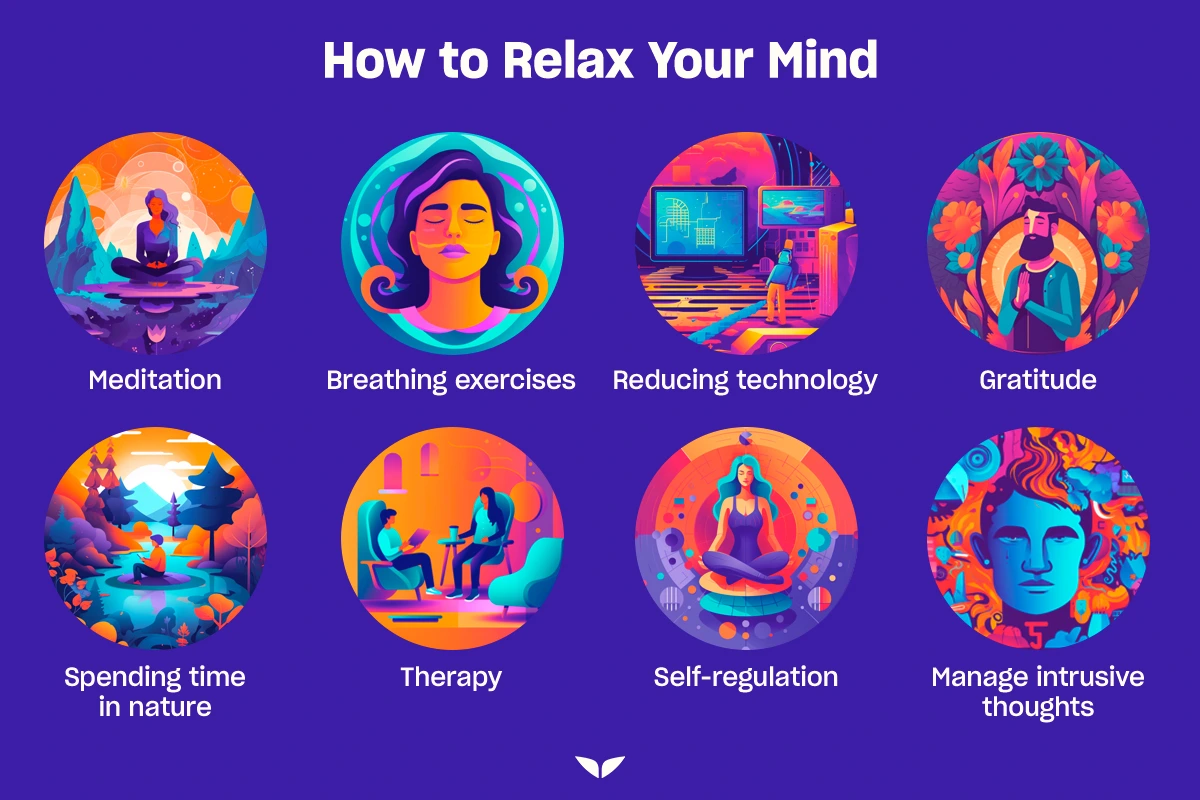In today’s fast-paced world, you may often find yourself tangled in a web of never-ending tasks and endless worries. However, even when it might seem daunting, the benefits of learning how to relax your mind will spill over into your general well-being.
After all, who wouldn’t want a little more Zen in their life? With the guidance and expertise of Dr. Caroline Leaf, a cognitive neuroscientist who’s also the trainer of Mindvalley’s Calm Mind: A Scientific Guide to Managing Anxiety and Depression program, you can learn a few techniques on how to exit the labyrinth of your chaotic thoughts.
And even if you’ve lived your entire life far away from the mental tranquility you desire, it’s important to know that “what you’ve wired in, you can wire out,” as she explains.
How to relax your mind and body from anxiety
Anxiety is like a relentless, uninvited guest at a party. It sneaks in and starts whispering in your ear, making it difficult to truly enjoy the moment. If you’ve ever experienced that nagging feeling of worry, you’re all too familiar with the mind-body connection—how your thoughts can influence the way your body feels and vice versa.
“Where your mind goes, your brain and body follow, and then your life follows,” explains Dr. Leaf in her Mindvalley program. “So if we don’t know what our mind is and how it drives the brain and the body, an unmanaged mind will mean an unmanaged brain, an unmanaged body, and an unmanaged life.”
And unfortunately, anxiety is so prevalent nowadays that 7.3% of people worldwide struggle with its debilitating symptoms, according to a 2010 study.
However, you can rewire your toxic, anxious thought patterns by using Dr. Leaf’s Neurocycle® process. It’s a five-step mind-management tool that creates long-lasting change if repeated 63 days in a row.
Here are the steps for you to try:
1. Gather awareness
The first step in learning how to clear your mind and relax is consciously creating space to observe yourself. In Dr. Leaf’s perspective, this means becoming aware of your warning signals, which can be:
- Emotional
- Physical
- Behavioral
- Related to perspective
Taking a few minutes each day to check in with yourself and notice your state of being as a whole can create tremendous change in the long run.
2. Reflect
During this part of the process, you can ask yourself:
- Why do I feel this emotion? What triggered it?
- Why do I think I feel this way?
“So as you reflect,” says Dr. Leaf, “you force this very deep interaction in the middle of the brain, and that allows you to get deeper insight.”
3. Write down your Metacog®
The Metacog® is Dr. Leaf’s way of structuring information that mirrors how your thoughts are created in your brain, similar to trees. They’re rooted in experiences and have branched out into interpretations.
All you have to do is write down the main anxious thought pattern that you’d like to work on. Then, as branches connect to a tree trunk, write down any associated emotional warning signs, perspectives, physical manifestations, toxic issues, and behaviors.
4. Recheck
The recheck step is all about reviewing what you’ve already written down and adding anything you may have missed along the way. This part makes space for new understandings of the issues you’re working to change.
Rechecking activates theta brain waves, which open up space for healing. And as Dr. Leaf highlights from her clinical practice, patients report experiencing a deeper sense of calm and inner peace when going into a theta brain state.
5. Active reach
Active reach is a constructive statement that reinforces your new neural networks. This new positive thought can be an anchor that you rely on throughout the day.
The active reach statement can be simple and concise. For example, for someone struggling with anxiety, it can simply sound like, “I’m not the anxiety I’m feeling; I’m just learning to deal with it.”
Learn more: Regain Your Inner Peace: 15 Mindfulness Practices for Anxiety
How to relax your mind to sleep
We’ve all been there—tossing and turning, counting sheep, or replaying the most embarrassing moments of the day as we desperately try to catch some zzz’s. Sleep is as essential to our well-being as air and water, yet many of us struggle to get enough shut-eye.
And in fact, lack of sleep is not only frustrating but it’s also shown to have a degrading effect on various cognitive functions. Studies have found that sleep deprivation affects people’s cognitive performance, decision-making, attention, and emotional regulation.
Here are a few ways to deal with it:
1. Diagram your intrusive thoughts
There’s nothing more frustrating than a racing mind just as you lay down to fall asleep.
“Intrusive thoughts can often feel like a volcano,” explains Dr. Leaf. “And if you think of a volcano, it’s dormant for a period, builds and builds, and then erupts.”
However, what you can do to prevent going down that never-ending spiral of thoughts is to deconstruct them before the explosion. And a helpful practice to deconstruct an intrusive thought and remold it into a brighter one is to create a thought diagram.
You can start by writing down the following:
- Give your intrusive thought a name, and describe it.
- How is this playing out in your life now?
- How did it affect you in the past?
- How could it affect your future?
- Where is this coming from?
The point of the exercise is to release some pressure from your mind’s busy activity, which may help you have more mental space to drift easily to sleep.
2. Practice relaxation techniques
Meditation and deep breathing are like lullabies for your mind. So before going to bed, you can set up a practice and settle into a comfortable position.
Just focus on your breath or a soothing mantra, allowing your thoughts to drift by like clouds in a serene sky.
And if you need some help to release any anxiety-inducing thoughts before sleep, you can download the Mindvalley app for some free guided meditations.
There are some that may spark your interest, and you could try out Marisa Peer’s meditation, who’s also the trainer of Mindvalley’s Rapid Transformational Hypnotherapy for Abundance program, on how to clear your mind and release anxiety.
3. Reduce technology before bed
Screens emit blue light, which is like a loud techno beat that keeps your brain awake and dancing. Try to cut off screen time at least an hour before bed, so your brain can slow dance into slumber instead.
In fact, studies have shown that this exposure led to significant suppression of melatonin secretion, which is a hormone responsible for regulating sleep-wake cycles. The study also showed that exposure to blue light increased alertness and impacted cognitive performance, making it more difficult for participants to fall asleep.
Learn more: Struggling to Sleep? Here’s How to Fix Your Sleep Schedule
How to relax your mind from overthinking
Overthinking is like a hamster running on a wheel in your mind. The more you think, the faster it spins, but you never seem to get anywhere.
And according to a 2013 study published in the Journal of Abnormal Psychology, overthinking, also known as rumination, is linked to the development of depression, anxiety, binge eating, and self-harm.
So, how do you hit the brakes on this mental hamster wheel? Here are a few tips that may help:
1. Master self-regulation with the Multiple Perspective Advantage
The Multiple Perspective Advantage (MPA) is the deliberate process of standing outside yourself, observing your thoughts, words, and actions, and changing them, explains Dr. Leaf.
And practicing it daily can increase alpha brain waves and bring your brain into balance, which decreases anxiety, depression, and overthinking. To start, you can set the intention to observe how you react at work or in your relationships and notice what frustrates or upsets you.
The mere act of awareness and observation may bring a sense of calm to your brain and drive you toward a state of equilibrium.
2. Process thoughts and emotions with breathing exercises
When going down the rabbit hole of overthinking and anxiety, your body enters the “fight or flight” state. You unconsciously start breathing faster and inhaling more oxygen than is natural. This disrupts your body’s balance of oxygen and carbon dioxide.
Research shows that regular practice of breathwork can help reduce stress, anxiety, and depression. It does so by modulating the balance between the sympathetic (fight or flight) and parasympathetic (rest and digest) branches of the autonomic nervous system.
This, in turn, can promote relaxation and improve overall mental health.
Learn more: How to Combat Anxiety Using SOMA Breath®
3. Therapy
Therapy can be an incredibly powerful tool for managing and rewriting those seemingly never-ending thought patterns. It’s like having a personal trainer for your brain. Plus, therapists are trained to help you identify and challenge negative beliefs, develop coping strategies, and create a personalized treatment plan.
Sometimes, when you’re feeling overwhelmed with too many thoughts, professional guidance makes the process of integrating new practices smoother and more accessible. And remember that there’s no shame in seeking help from a professional; it might be just the extra support you need to gain emotional freedom.
How to relax your mind from stress
Stress is like an unwelcome party crasher that wreaks havoc on your mental and physical health. And science agrees with it, too.
One 2007 study provides an overview of research on the connection between psychological stress and various health issues, including heart disease, obesity, and mental disorders.
But there are some tips and tricks to help you learn how to relax your mind when stressed and release some of the overwhelming pressure that weighs you down:
1. Understand your warning signals
According to Dr. Caroline, your warning signals are like your personal superhero sidekicks, always there to save the day. Learning to tune in to these signals can build your self-regulation and resiliency skills, making you stronger, less stressed, and more in control of your life.
You can reflect on the four types of signals that your inner world is giving out:
- What emotional warning signals do you experience?
- What physical warning signals show up every day?
- Which behavioral warning signals are most present in your day-to-day life?
- Which perspective warning signals are most common in your life?
Just reflect on each category of these messages and write down any signs you observe. And doing this exercise for as little as five minutes a day can increase your self-regulation abilities.
2. Practice gratitude
Studies have shown that expressing gratitude on a daily basis promotes higher levels of overall happiness and contentment. Moreover, it is strongly associated with well-being and, as the studies reported, this link may be unique and causal.
By disabling painful or seemingly debilitating problems, the simple act of practicing gratitude can bring joy, hope, and light to the darkest of times. And focusing on what is already working out in your life may decrease the stress of what you haven’t yet achieved.
Learn more: Revolutionize Your Mindset: How to Create a Gratitude Journal Practice
3. Spend more time in nature
Taking a walk in nature is like getting a big, green hug from Mother Earth herself. She gently invites you to set aside those screens and deadlines for a few moments.
And it’s not only Mother Nature calling you to the green lands. Studies show that spending time outside can lower cortisol levels, the hormone responsible for increased levels of stress.
So go ahead, grab your favorite walking shoes, and let the great outdoors work its stress-busting magic.

Long-lasting change starts with a relaxed mind
As with any great invention, everything started with a thought. So when designing your most desired life, you should make sure that your mind is calm and ready to come up with brilliant ideas.
And if you’re looking for some guidance on how to navigate the waters of your stormy mind, Mindvalley’s Calm Mind: A Scientific Guide to Managing Anxiety and Depression program may be the answer you’re looking for. With Dr. Caroline Leaf’s science-backed techniques, you can transform your life from the inside out and find the inner peace you have been seeking all along.
Here’s what Mindvalley students are saying:
In just two short days into the quest, I was able to get to the root cause of some old beliefs that I was aware of, but never really shifted completely. Thanks to this quest and Dr. Caroline Leaf, I now know how worthy I am of an extraordinary life, and my past no longer defines my future.
— Dijana Llugolli, coach, from Stockholm, Sweden
And by claiming your free access, you get to sample classes from this program and many others and see how this powerful wisdom will change your mind for the better.
Everything you’ve been searching for was waiting for you all along. You might’ve just needed a calmer state of mind to see it.
Welcome in.









